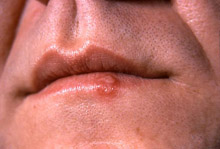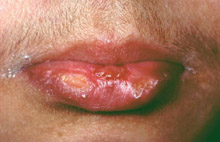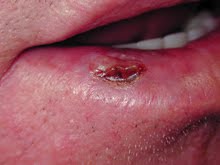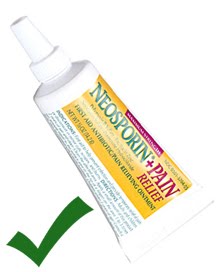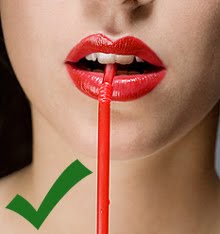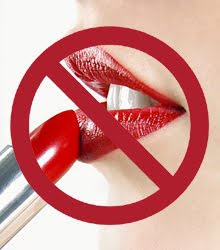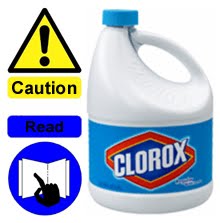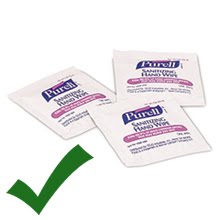This is a proven, highly effective treatment involving simple household products combined with a specific multi-step technique. Established medical and scientific journals have acknowledged the concept behind this method for years. However, it can be dangerous if done incorrectly or carelessly, and therefore considered medically unorthodox by most physicians. Aside from the safety concerns; if all steps are followed precisely as described, this is by far the fastest course of action you can take to kill your cold sore dead. Proceed at your own risk with care.
This method should only be attempted on minor HSV-1 early stage cold sore blisters or aphthous ulcers (canker sores) that are located on the outer or upper/lower lip (between the lips). Weeping or crusting blisters may also benefit, although possible damage to newly formed scabs and tissue may delay healing. Therefore, late stage blisters are not recommended for this treatment. Mucous membrane sores in the mouth or nose should never be treated with this method. See photo on the top right side titled “Minor Cold Sore”. The earlier you detect and treat the sore, the faster your recovery will be. Read the warnings and skin discoloration risks shown below before you get started.
Get a white (no pattern) paper towel sheet. Cut it down to roughly 3” x 6”. Fold it over 4 times into a small rectangle about ¾” x 1-½” (so you can grab the end). It should be around 16 layers thick by the time you’re done folding it over. The size of the folded mini-towel should be about as wide as the sore you’re trying to treat. Soak it in 91% to 99% isopropyl alcohol. Pinch it lightly with your fingers to squeeze off excess alcohol that may drip into your mouth and contact your tongue. Hold it in place on the sore between your lips until you need to swallow.
The pain will only be intense for a few minutes as the nerves become numb from the alcohol. If you have a small fan, blow it towards your face to redirect the alcohol fumes. Take the mini-towel out to swallow, then reposition it back on the sore. If holding it in your mouth with your lips isn’t possible due to the sore’s location, the use of a latex glove or Saran wrap protecting your fingers is recommended. Re-soak the mini-towel every 15-minutes in alcohol, then pinch off the excess and reposition it back on the sore.
The target duration is to reach 45-minutes of continued direct contact so the alcohol saturates the inner layers of the skin where the outbreak initially self-replicated. After this step is complete, you have basically transformed your cold sore into a common sore (like a scrape or a bruise) which heals on average 3-6 times faster given the right conditions.
You should now apply just a small amount of Neosporin antibiotic ointment on the sore. Drink liquid food supplements (like Ensure by Abbott Labs or Boost by Nestlé HealthCare Nutrition) and water only through a straw for the rest of the day. If at all possible, continue the straw-fed regimen the following day. You can supplement nuts and small fruit like grapes or berries that simply pop into your mouth without touching your sore. Bite-sized food that's bland and doesn’t require lip contact to separate (unlike a deli sandwich or spaghetti) should be fine. This will dramatically improve healing by keeping the sore dry, and away from aggravating salty or acidic foods.
WARNING: You need to examine your sore and the surrounding tissue every 5-minutes in a mirror during the 45-minute alcohol application period. Doing this will reduce the likelihood of an adverse event becoming a significant risk. Some people have an allergic reaction to isopropyl alcohol which is why it’s so important to check the status regularly. Obvious swelling or redness is a sign you should stop and check back in two hours. Do not substitute the alcohol with other chemicals such as hydrogen peroxide or nail polish remover. This can result in serious tissue damage requiring a hospital visit, as well as make you very sick. Keep the alcohol away from your eyes and nose. Wearing swimming goggles combined with the use of a fan directed towards your face during this process is strongly advised. The fumes alone can cause severe eye, nose, throat, and respiratory irritation lasting for days. Be very careful with the alcohol so close to your face.
Skin pigmentation discoloration and the development of dermal hypersensitivity associated with frequent and/or prolonged contact with isopropyl alcohol: Most of the data readily available associated with these rare occurrences involve OSHA Material Safety Data Sheets (MSDSs) intended for workplace safety. Factory workers involved in large scale daily production are considered at risk. (See additional studies in PDF below.) The point being made here is that an established link between exposure and long term adverse events exists. In relationship to this treatment’s alcohol exposure duration and surface area affected, the risks should be quite low. However, no long term controlled study presently exists representing this treatment. If you have a pigmentation disorder (Vitiligo) or very parched, easily irritated skin or scalp/hair, this would not be an advisable solution to undertake.
If you’re concerned with the risks but still want to try the treatment, start off very slow. Start out with only 1 or 2-minutes of alcohol skin contact using a cotton swab (vs. the mini-towel). Every 3-hours of the day apply the swab for another 1 or 2-minutes. This is not as effective, but it will reduce the healing time. Follow the rest of the treatment steps. You can slowly up your alcohol application time as you become more familiar with the results. By the next time you get an outbreak, you’ll know weather or not you can zap it out with the target 45-minutes from your previous trials.
The controversy over the use of bleach: Household chlorine bleach is 5 to 6% sodium hypochlorite (a stabilized derivative of diatomic chlorine gas). This is a strong oxidizing agent capable of serious burns and cellular damage if not carefully diluted. Oxygen or peroxide bleach which contains hydrogen peroxide or peroxide-releasing compounds is a progressive, fast acting oxidizer. This makes it hard to predict outcome on a delicate lip sore. Sodium chlorate is another bleaching compound you’ll hopefully never run into. Due to an EC decision on the chemical and its associated hazards, it will be withdrawn from the market as of May 10th, 2010. Bleach does not discriminate between healthy and unhealthy cells, and at elevated concentrations, skin tissue will begin to break down as the powerful oxidizer works to sterilize everything in its path.
However, there is the rare exception. When bleach is diluted to about 60% strength (36,000-ppm) using the Clorox brand 6% sodium hypochlorite, it has been shown to be effective on cold sores using short duration applications. The first day of this treatment you’ll need to carry around a timer, cotton swabs, and worst of all, the diluted bleach. Like Houdini, bleach can work its way out of a container causing permanent damage to clothes, car seats/chairs, or carpet. Carry the smallest amount possible in a reliable hermetically sealed screw cap container, and reseal the container in a Ziploc bag. The steps to this method are as follows: Hold a saturated swab 1 to 2-minutes on the early stage blister. Don’t rub the swab to attain full coverage. If the blister is larger than the swab’s tip, use two swabs. Repeat the process every 3-hours with no more than 6 applications in 24-hours. You should experience positive results the following day. If possible, start this treatment when you first wake up so you can follow through with at least 4 of the 6 consecutive tri-hourly applications. This is essential because each application is significantly dependant on the other to bring down the infection.
Compared with isopropyl alcohol, the use of bleach is less effective, although still provides better results than most OTC medications. Bleach is a more powerful germicide, and thus lacks restraint during its search and destroy mission for pathogens. Isopropyl alcohol is absorbed more efficiently and targets the viral infection with less collateral damage to healthy live cells. Bleach cannot be used in adequate strengths for extended periods because of its destructive nature. In addition, concentration levels in chlorine bleach are not monitored as closely as FDA approved skin disinfectants. Because bleach comes in so many different brands, mixtures and strengths, calculating acceptable dilution ratios without knowing what you’re using would be ridiculous. Despite bleach not being an allergen, tolerance levels vary widely from person to person. Minuscule amounts can react with other substances to cause serious problems. Furthermore, chlorine’s toxicity threshold is so vast, it’s currently undefined. Therefore, bleach is not recommended unless you know exactly what you’re getting into.
The controversy over the use of ice: Some people have claimed ice has helped shrink the cold sore resulting in an accelerated healing. Others have gone so far as to say the repeated use of ice has killed off the virus completely. In actuality, to kill off the cold sore with the use of ice alone, you would have to use the dry form which would be insane. At temperatures below 195-K (-78.2 °C, -108.7 °F) on delicate facial tissue, dry ice will cause serious burns, and likely lead to permanent scaring. Therefore, never attempt to use wart removal kits of any kind for this purpose.
Water ice wafers can be made by simply filling an ice tray ¼ of the way full. The ice wafers are thin enough to fit nicely between the lips while reducing the risk of chilling a tooth nerve (vs. a full size cube). The ice will numb the pain providing some short term relief. However, ice unfortunately produces additional moisture which is what the virus thrives on. Putting the ice in a plastic bag is a far better idea if you feel you need it. Overall, the use of ice on canker sores (especially blister stage oral herpes) has shown inadequate results in randomized controlled clinical trials as well as large scale systematic reviews. Some physicians recommend it, so if you feel it’s effective, then continue using the ice in a bag.
Fomite removal is a crucial last step in the recovery process. Replace your toothbrush with a brand new one. Swap out your washcloth, bed pillow covers (bed sheets too if you want to be extra careful). Thoroughly wash coffee cups, glassware and utensils. Toss out the used Chapstick/lip ointments that may have been in contact with your sore. Sorry, but yes… Stay away from your spouse/kids until it heals. This method is also effective on Athlete's Foot (tinea pedis) fungal infection.
As with all medical advice, talk to a qualified healthcare professional about your medical conditions before undertaking any treatment. Getting multiple opinions before making a decision is always a good idea. Be careful with this information provided, and good luck.
Written by Lab Rat v-Ki-ras2
Thursday, October 1, 2009
Subscribe to:
Posts (Atom)
